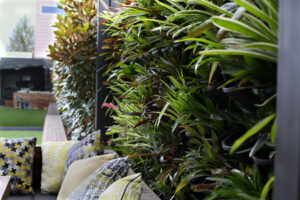
What’s roadblocking urban greening projects?
By Michael Casey
Green infrastructure projects can be incredibly beneficial for the environment and communities, but they can also come with challenges when trying to plan and be granted approval to build these into our built environments. Our councils are on board, communities love the introduction of nature spaces and our planners and designers understand more about the added benefits of introducing green infrastructure into their designs. With this increased support and interest why are we not seeing more built projects around our cities and communities.
Green infrastructure is a relatively new industry and profession in Australia, and one that is now becoming a very popular career choice for many people wanting to be more active in the design, installation, and maintenance of green spaces in built environments. Green infrastructure is a solution to urban and rural planning that emphasizes the incorporation of nature and natural processes into the built environment to create more sustainable and resilient communities. It includes green spaces such as forests, wetlands, parks, green roofs, and other green spaces, designed and managed to provide various environmental, economic, and social benefits to communities. The great thing about green infrastructure is the many professional disciplines and the breadth of knowledge that can be found working in this profession. With all these professions working towards a greener future we now must look at where the roadblocks are that are inhibiting future projects.
Cost and funding of these projects, which includes both the professional costs and material costs, are a major issue when the inclusion of green spaces is discussed. Significant costs associated with planning and design are a huge overhead when pricing a potential project and rightfully so with the complexities of these infrastructure projects. One green wall might require the work of planners, architects, green infrastructure specialists, and engineers to name just a few. These professionals are required to work together as their knowledge all leans towards the success and integrity of the installation, and this is all prior to the works being commissioned. These initial prices and overall project costs may also need to compete against other higher priority inclusions.

Green infrastructure projects often need to adhere to local regulations and obtain necessary permits. Navigating the regulatory environment can be time-consuming and complicated, potentially causing delays in project initiation. These regulatory and permitting hurdles can lead to frustration, when delays in the overall project are held up due to permits not being issued in a timely manner. Some of the reasons for these delays is the level of knowledge some planners and councils have in green infrastructure. Improvements with training and further education in these sectors may assist in increasing understanding of the projects allowing for permits to be granted in a timelier manner.
When it comes to gathering support from the community on greening their neighbourhoods, we have seen unparalleled support with many community members often installing their own green spaces such as community gardens, greening of nature strips and greening laneways to name just a few. But there are some examples where a lack of understanding about the benefits of green infrastructure has seen the roadblocking of some projects due to costs outweighing social and environmental benefits.
The building industry has been a bit slower to take on these projects as costs and fears such as warranty issues, along with limited contractors and high installation costs, have been some of the reasons why green infrastructure projects end up being cut from building schedules. It’s also been observed that there can be some scepticism around the performance and benefits of green infrastructure, especially if they are more familiar with traditional grey infrastructure solutions. We, as the industry, need to help alleviate these thoughts by providing clear evidence of the positive impacts, and long-term cost savings, that green infrastructure can deliver.
As green infrastructure solutions are incorporated into and around the built environment, projects often need to be integrated with existing grey infrastructure systems in a timely and seamless manner. This can be complex and may require careful coordination of experienced project managers and engineers, especially when timing and handover of projects are tight.
With the hope that more green infrastructure projects will be designed into our built environment, and with future governments possibly mandating more green spaces, we need to ensure the industry has the workforce to install, and more importantly maintain, these installations. To ensure the success and functionality of installations the industry must have trained and knowledgeable professionals working in the field. At present the industry is working towards standards and training but without this level of skill, projects may fail and not deliver on their expected benefits.
And finally, let’s do more to collect data and monitor these installations. The importance of conducting thorough research through the engagement with stakeholders and professionals will build a greater knowledgeable and skilled professional and industry, help to secure sufficient funding, and develop a comprehensive and strategic plan that accounts for the unique challenges of green infrastructure projects.
Michael Casey,
Director, Evergreen Infrastructure
Consultant and advisor to
The Green Infrastructure Industry.
E: michael@evergreeninfrastructure.com.au
